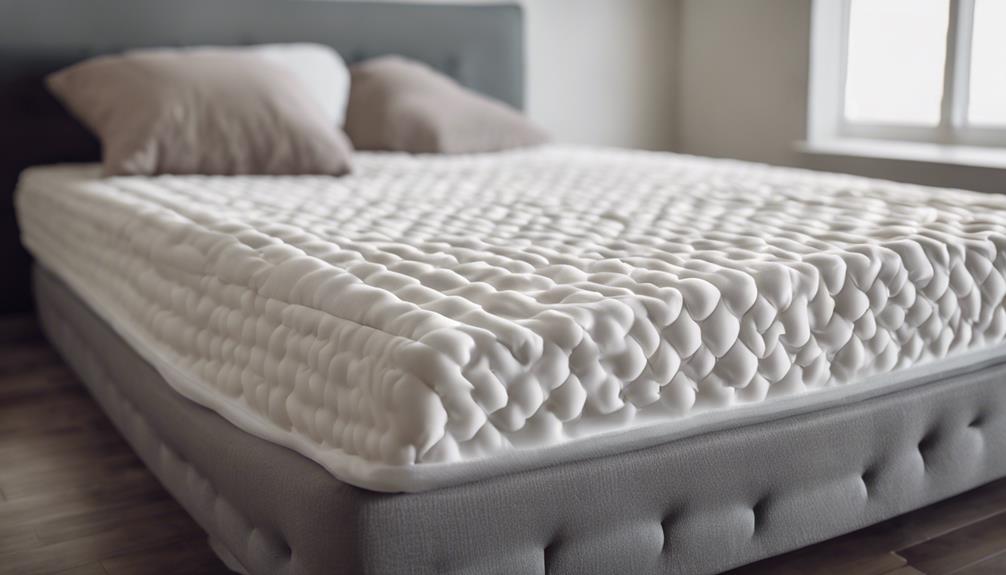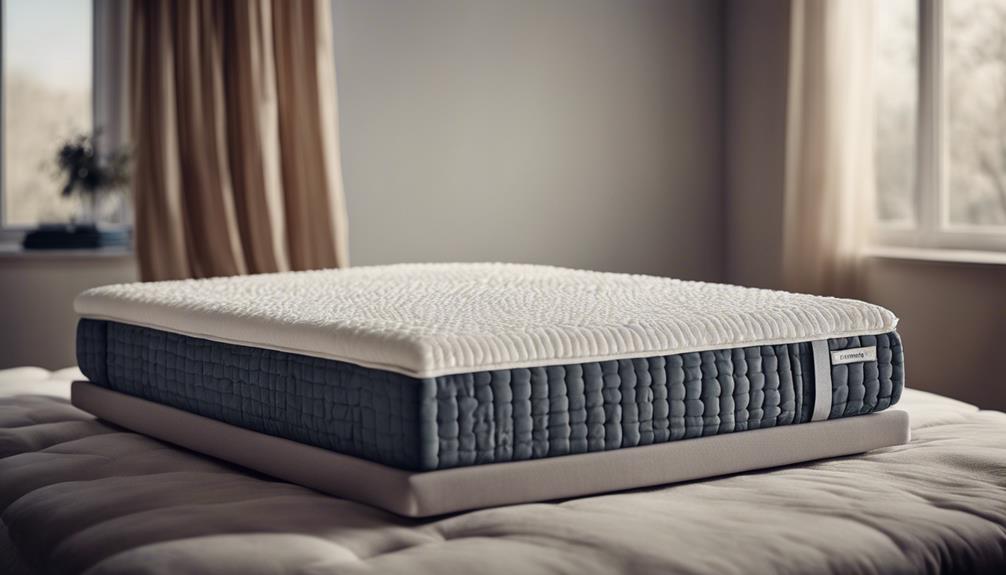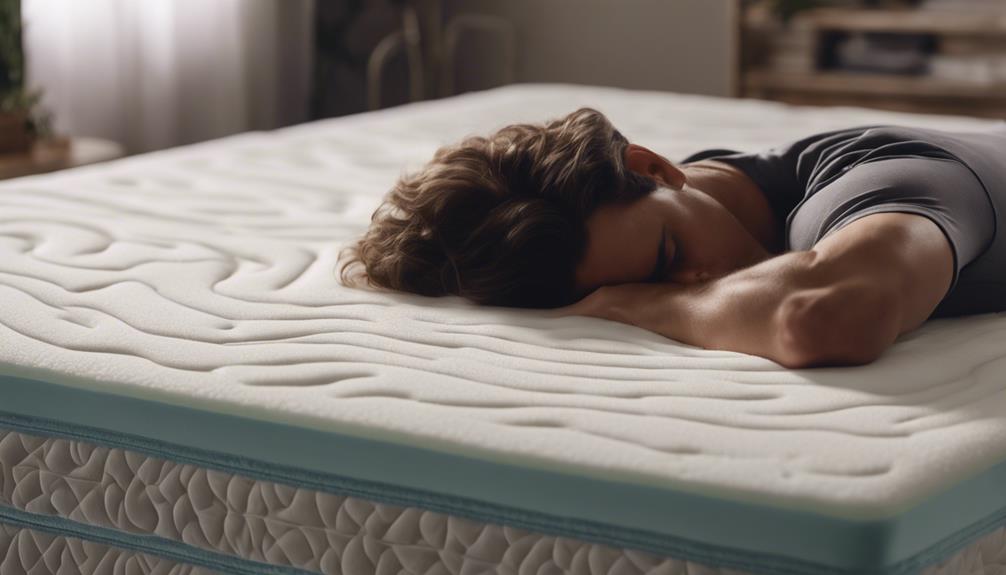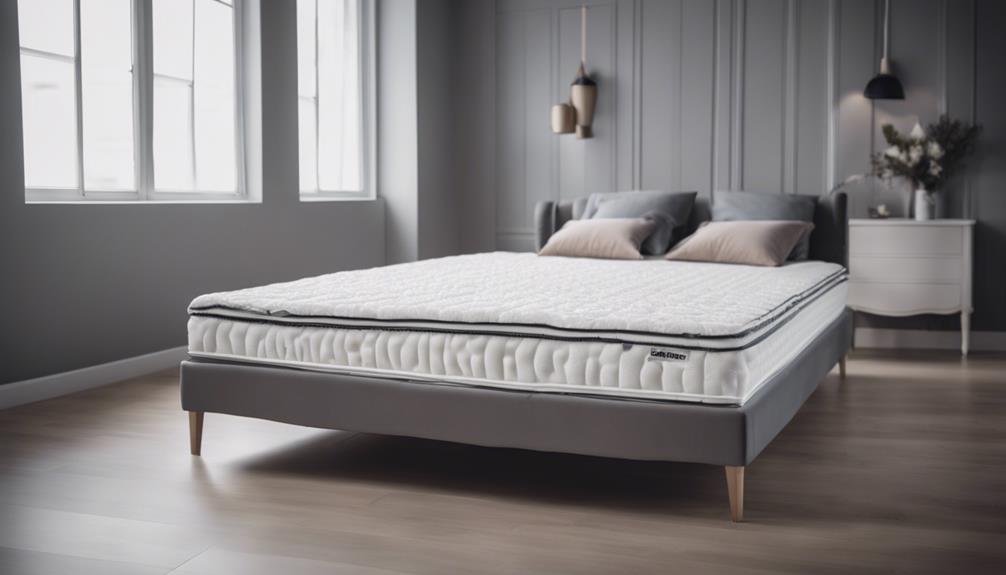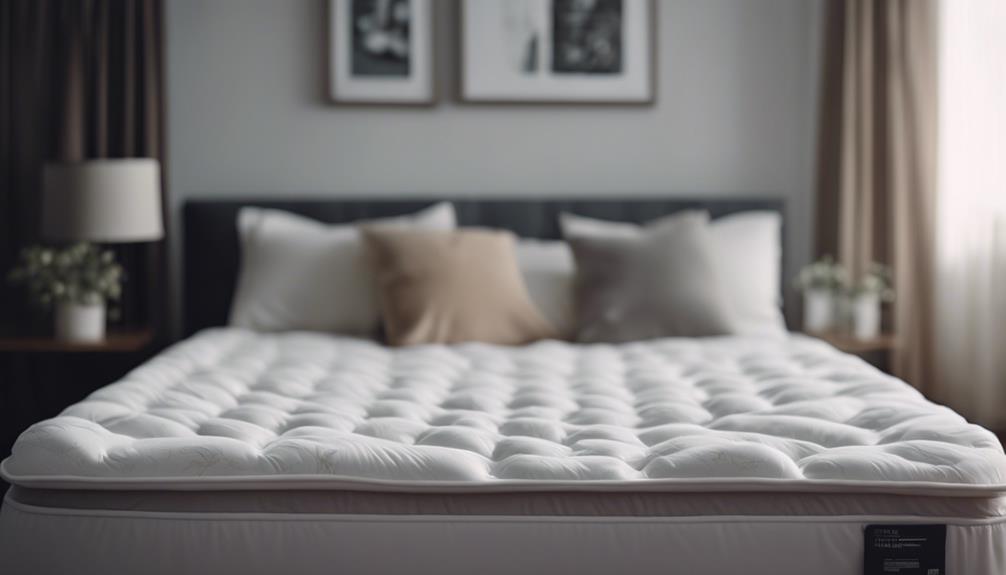Using a mattress topper as a standalone mattress can lead to discomfort, inadequate spinal support, and void warranties. Toppers aren't designed to provide the same level of support as mattresses, potentially causing long-term issues. Limited pressure relief and a shorter lifespan compared to mattresses are important factors to take into account. Toppers lack the durability for long-term use and may compromise comfort. Possible aches, pains, and warranty problems could arise from prolonged use. Affordable mattress options like Siena Memory Foam and Zinus Green Tea Luxe under $300 provide cost-effective solutions. Explore considerations like depth and materials to align with long-term sleep needs.
Key Takeaways
- Toppers lack proper spinal support for long-term use.
- Limited pressure relief compared to mattresses.
- Toppers have shorter lifespan than mattresses.
- Budget-friendly mattresses offer better long-term comfort.
- Using topper as mattress may lead to discomfort and warranty issues.
Risks of Using Mattress Topper as Mattress
Using a mattress topper instead of a mattress poses potential risks such as discomfort, warranty concerns, and inadequate spinal support. While mattress toppers can provide added cushioning and enhance the feel of a mattress, they aren't designed to offer the same level of support as a proper mattress. This lack of proper spinal support can lead to long-term issues such as aches and pains, impacting pressure relief and overall comfort. Additionally, using a mattress topper as a mattress can void warranties as manufacturers typically recommend using their products with proper bedding for quality sleep.
It is important to keep in mind that standalone mattresses have a longer lifespan than mattress toppers, emphasizing the temporary nature of using a topper as a bed. While using a mattress topper as a mattress may be suitable for short-term scenarios like camping trips or accommodating unexpected guests, it isn't a recommended practice for long-term use due to the potential risks involved. To maintain proper spinal support, pressure relief, and overall comfort, it's advisable to replace mattresses every seven years and invest in a quality mattress for optimal sleep health.
Lack of Proper Spinal Support
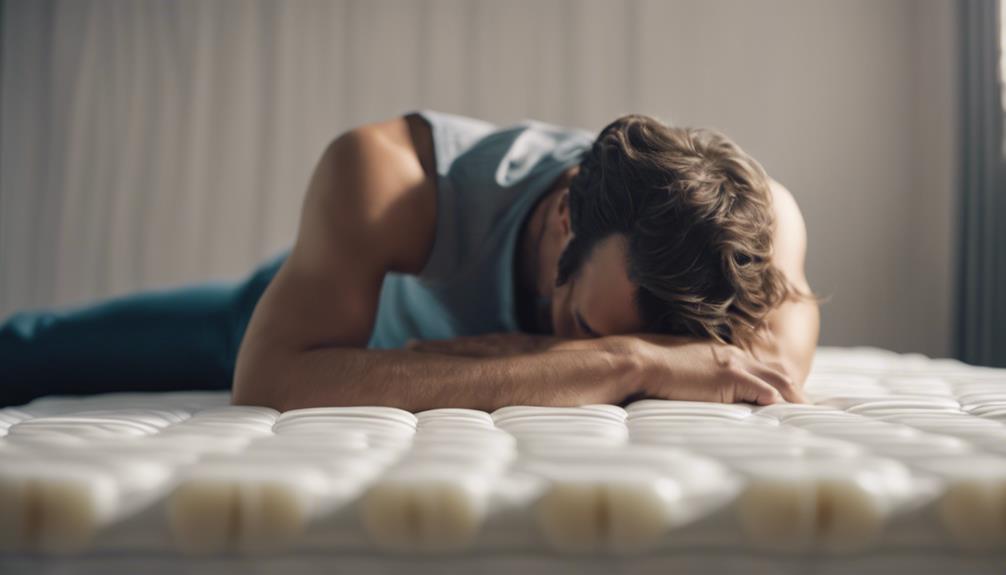
When using a mattress topper instead of a proper mattress, it's important to be aware of the lack of adequate spinal support. Without proper support, our bodies can experience discomfort, leading to aches and pains.
We should prioritize spinal alignment, especially when considering a mattress topper as a standalone sleeping surface.
Spinal Alignment Importance
Proper spinal alignment due to insufficient support from a mattress topper can lead to discomfort, aches, and poor sleep quality.
When using a mattress topper as a mattress, it's important to take into account the impact on spinal health and overall comfort. Without adequate spinal support, the body weight distribution may not be even, potentially causing pressure points in areas such as shoulders and hips.
This can result in aches and pains, disrupting sleep quality and leading to grogginess upon waking. To avoid these issues, make sure that your mattress topper provides sufficient support for proper alignment and even weight distribution throughout the body.
Toppers for Back Pain
Considering the lack of proper spinal support, mattress toppers can contribute to back pain issues. When using a mattress topper, especially as a mattress replacement, it may not provide the necessary support for your spine. This lack of alignment can lead to discomfort and potential back pain.
Toppers, especially those lacking firmness or adequate padding like memory foam mattresses, may not distribute body weight evenly, creating painful pressure points in areas such as shoulders and hips. Sleeping on a topper that doesn't offer sufficient support can result in poor sleep quality, leaving you feeling tired and groggy upon waking.
To address back pain, it's crucial to make sure that the topper you choose provides the necessary support and comfort for your spine.
Mattress Firmness Impact
Using a mattress topper without sufficient firmness can lead to discomfort and misalignment, affecting spinal support. Here are some impacts of using a topper without proper firmness:
- Uneven weight distribution due to firm toppers can create painful pressure points, especially in areas like shoulders and hips.
- Inadequate support may result in poor sleep quality, leaving you tired due to lack of cushioning.
- Toppers mightn't conform well to body shape, impacting comfort and causing discomfort and pain during sleep.
- Manufacturer approval is essential, as relying solely on a topper as a mattress can compromise comfort and support levels.
Limited Pressure Relief
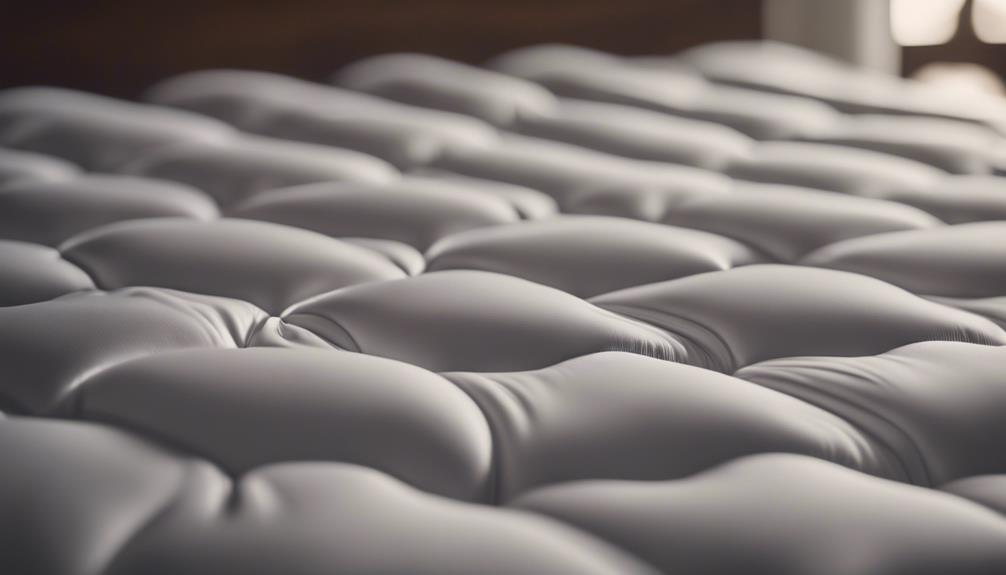
Mattress toppers provide only limited relief from pressure on key areas such as shoulders, hips, and back when compared to traditional mattresses. Due to their design, toppers may not effectively distribute body weight, leading to painful pressure points, especially in the shoulders and hips. This inadequate support can result in poor sleep quality and discomfort when using a topper as a standalone bed.
The lack of proper padding and the failure to conform well to the body's shape can cause discomfort and pain during sleep. Toppers may feel firm and lack the necessary cushioning to provide adequate relief for pressure points. Without manufacturer approval, relying solely on a topper as a mattress replacement can lead to misalignment, discomfort, and compromised sleep quality.
To avoid these issues, it's essential to take into account the limitations of mattress toppers regarding pressure relief and support. If pressure points and discomfort persist, it may be necessary to invest in a suitable mattress that offers better body support and alleviates pain for a restful night's sleep.
Short Lifespan Compared to Mattresses
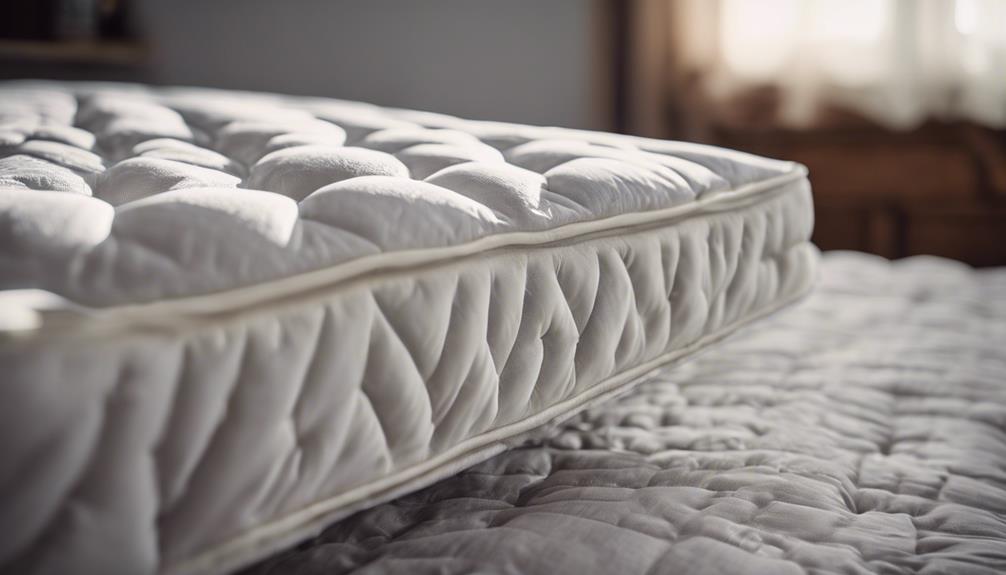
Mattress toppers, unlike traditional mattresses, have a significantly shorter lifespan, often lasting only 2-3 years.
This difference in longevity can be a crucial factor to keep in mind when deciding between the two options.
The need for more frequent topper replacements due to wear and tear should be taken into consideration for those seeking long-term comfort and support.
Topper Durability Concerns
When contemplating a mattress topper as a long-term solution, its durability compared to traditional mattresses becomes an essential factor to assess. Here are some points to ponder regarding the durability concerns of mattress toppers:
- Mattress toppers have a shorter lifespan than standalone mattresses, often requiring replacement sooner.
- The limited durability of mattress toppers can impact their long-term use as a substitute for mattresses.
- Using a mattress topper as a mattress may lead to quicker wear and tear, diminishing its effectiveness over time.
- Toppers mightn't offer the same longevity and support as regular mattresses, potentially affecting sleep quality.
Investment Longevity Differences
Considering the investment longevity differences between mattress toppers and traditional mattresses, it becomes evident that toppers generally offer a shorter lifespan. Mattress toppers, designed as a temporary solution, aren't meant for long-term use compared to mattresses. Over time, the wear and tear on mattress toppers can compromise their effectiveness, leading to quicker deterioration and a lack of support.
In addition, using a mattress topper as a standalone mattress may void warranties, impacting potential returns or replacements. Due to the lack of spinal support and pressure relief in toppers, prolonged use can result in discomfort and affect sleep quality. It's crucial to recognize that while mattress toppers can enhance comfort temporarily, they aren't a substitute for the long-term benefits provided by traditional mattresses.
Replacement Frequency Comparison
Investing in a mattress topper necessitates considering its shorter lifespan compared to traditional mattresses, leading to a more frequent need for replacement. When comparing the replacement frequency of mattress toppers to standalone mattresses:
- Lifespan: Toppers need replacement sooner than mattresses.
- Wear and Tear: Continuous use as a mattress accelerates wear and tear.
- Warranties: Using a topper as a mattress may void warranties.
- Cost-Effectiveness: Consider the long-term costs of replacing toppers versus investing in a new mattress for better comfort and support.
Understanding these factors is important in deciding between using a mattress topper and buying a new mattress to ensure a restful sleep experience.
Budget-Friendly Alternatives to Toppers
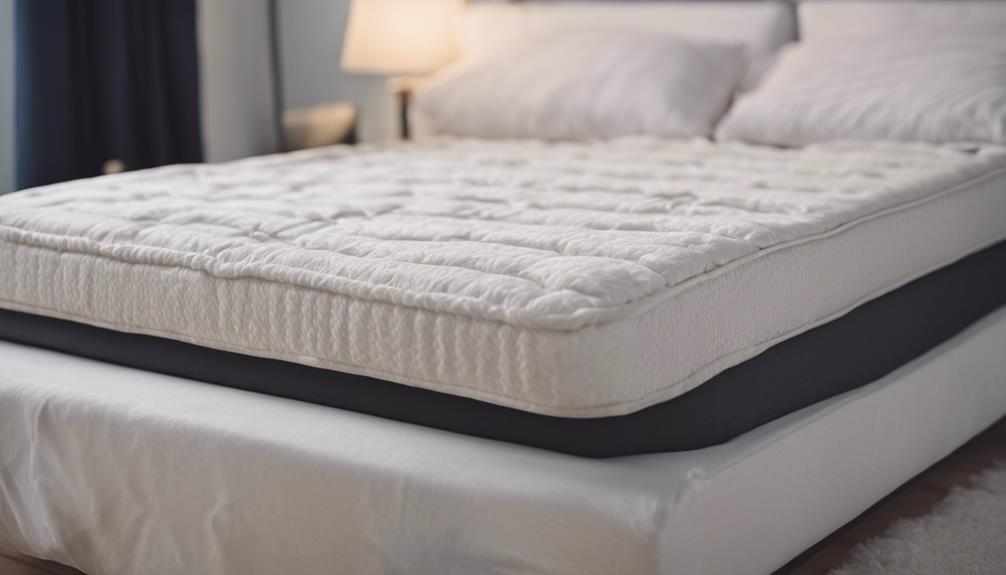
Looking for cost-effective options to enhance your mattress comfort? When considering budget-friendly alternatives to mattress toppers, affordable mattresses like the Siena Memory Foam Mattress and Zinus Green Tea Luxe are excellent choices under $300.
Compare prices between mattress toppers and discounted mattresses to find the most cost-effective solution for your needs. For instance, the Siena Memory Foam Mattress, originally priced at $499, is now available at a discounted price of $199, while the Lucid 10-Inch Gel Memory Foam Mattress, typically priced at $299.99, can be purchased at a reduced price of $229.99.
Considerations When Choosing Mattress Topper
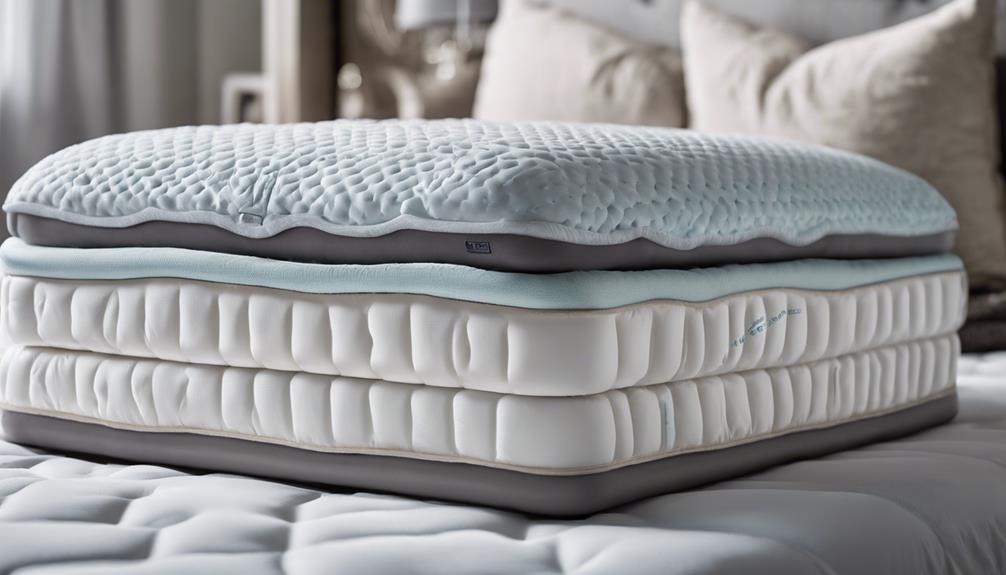
When exploring mattress toppers, one important aspect to keep in mind is the thickness for ensuring ideal comfort and support. Here are some key considerations when choosing a mattress topper:
- Thickness: Opt for a mattress topper with a minimum depth of 5cm to provide adequate comfort and support.
- Firmness: Look for materials like latex or memory foam for a firm mattress topper that can offer excellent spinal support.
- Purpose: Evaluate your needs, whether it's enhancing comfort, adjusting firmness, or protecting your mattress from wear and tear.
- Long-Term Use: While mattress toppers can be a temporary solution, prolonged use may lead to aches, pains, and potential issues with warranties. Consider if a mattress topper aligns with your long-term sleep goals.
Frequently Asked Questions
Can You Use a Mattress Topper Instead of a New Mattress?
Using a mattress topper as a full-time mattress replacement isn't advisable. While suitable for short-term needs, it lacks the necessary support for adults long term.
The topper may not offer even weight distribution, leading to discomfort and disturbed sleep.
It's essential for proper rest and health to invest in a suitable mattress with adequate support for a good night's sleep. Make sure to consult with the manufacturer for compatibility and best use.
Can a 4 Inch Mattress Topper Be Used as a Mattress?
Using a 4-inch mattress topper as a mattress isn't ideal for long-term use due to potential lack of support and comfort. While it can provide temporary comfort, it may not offer the necessary structure for adequate sleep.
Manufacturer approval is important for warranty validity and compatibility. Consider body weight distribution, pressure points, and overall sleep quality; using a topper as a mattress may lead to discomfort, misalignment, and inadequate padding.
Can I Sleep on Only a Mattress Topper?
We don't recommend sleeping solely on a mattress topper. While it might work for kids or short-term use, adults may find it uncomfortable. Toppers lack proper support, leading to body pain and poor sleep quality.
They can't distribute weight evenly, causing pressure points. For better rest, a quality mattress with a suitable topper is ideal. Consult the manufacturer for guidance to guarantee a restful night's sleep.
Will a Mattress Topper Help an Old Mattress?
Using a mattress topper on an old mattress can indeed work wonders. It adds extra comfort, support, and protection, revitalizing the old mattress.
By reducing pressure points and enhancing overall comfort, a mattress topper can greatly improve sleep quality. Plus, it's a cost-effective way to customize the firmness level according to our preferences without investing in a new mattress.
It's a win-win situation for both our comfort and our wallet!
Conclusion
To sum up, when contemplating, it's crucial to take into account that using a mattress topper as a mattress may entail risks such as lack of proper spinal support, limited pressure relief, and a shorter lifespan compared to actual mattresses. It's essential to bear in mind these factors before opting for a topper as your main sleeping surface.
There are budget-friendly alternatives to toppers that may provide better support and comfort for a good night's sleep. Make an informed decision based on your specific needs and preferences.
